Legume–Non-Legume Cover Crop Mixtures Enhance Soil Nutrient Availability and Physical Properties: A Meta-Analysis Across Chinese Agroecosystems
Abstract
1. Introduction
2. Materials and Methods
2.1. Literature Search and Data Compilation
2.2. Dataset Characteristics
2.3. Meta-Analysis Procedure
2.4. Model Diagnostics
3. Results
3.1. Effects of Cover Crop Species
3.2. Effects of Initial Soil Properties
3.3. Effects of Fertilizer Inputs
3.4. Effects of Planting Duration
4. Discussion
4.1. Impacts of Cover Crops on Soil Physicochemical Properties
4.2. Influence of Cover Crop Types
4.3. Modulating Effects of Initial Soil Properties
4.4. Interaction with Fertilizer Inputs
4.5. Impact of Cover Crop Duration
4.6. Future Perspectives and Research Needs
5. Conclusions
Supplementary Materials
Author Contributions
Funding
Data Availability Statement
Conflicts of Interest
References
- Ibarrola-Rivas, M.J.; Granados-Ramirez, R.; Nonhebel, S. Is the available cropland and water enough for food demand? A global perspective of the Land-Water-Food nexus. Adv. Water Resour. 2017, 110, 476–483. [Google Scholar] [CrossRef]
- Ernst, O.R.; Dogliotti, S.; Cadenazzi, M.; Kemanian, A.R. Shifting crop-pasture rotations to no-till annual cropping reduces soil quality and wheat yield. Field Crops Res. 2018, 217, 180–187. [Google Scholar] [CrossRef]
- Qin, S.H.; Yeboah, S.; Xu, X.X.; Liu, Y.H.; Yu, B. Analysis on Fungal Diversity in Rhizosphere Soil of Continuous Cropping Potato Subjected to Different Furrow-Ridge Mulching Managements. Front. Microbiol. 2017, 8, 845. [Google Scholar] [CrossRef]
- Soane, B.D.; Ball, B.C.; Arvidsson, J.; Basch, G.; Moreno, F.; Roger-Estrade, J. No-till in northern, western and south-western Europe: A review of problems and opportunities for crop production and the environment. Soil Tillage Res. 2012, 118, 66–87. [Google Scholar] [CrossRef]
- Holland, J.; Brown, J.L.; MacKenzie, K.; Neilson, R.; Piras, S.; McKenzie, B.M. Over winter cover crops provide yield benefits for spring barley and maintain soil health in northern Europe. Eur. J. Agron. 2021, 130, 126363. [Google Scholar] [CrossRef]
- Krupek, F.S.; Mizero, S.M.; Redfearn, D.; Basche, A. Assessing how cover crops close the soil health gap in on-farm experiments. Agric. Environ. Lett. 2022, 7, e20088. [Google Scholar] [CrossRef]
- Zhang, C.Z.; Xue, W.F.; Xue, J.R.; Zhang, J.; Qiu, L.J.; Chen, X.Y.; Hu, F.; Kardol, P.; Liu, M.Q. Leveraging functional traits of cover crops to coordinate crop productivity and soil health. J. Appl. Ecol. 2022, 59, 2627–2641. [Google Scholar] [CrossRef]
- Acharya, P.; Ghimire, R.; Acosta-Martinez, V. Cover crop-mediated soil carbon storage and soil health in semi-arid irrigated cropping systems. Agric. Ecosyst. Environ. 2024, 361, 108813. [Google Scholar] [CrossRef]
- Koudahe, K.; Allen, S.C.; Djaman, K. Critical review of the impact of cover crops on soil properties. Int. Soil Water Conserv. Res. 2022, 10, 343–354. [Google Scholar] [CrossRef]
- Zhang, Z.G.; An, J.; Xiong, S.W.; Li, X.F.; Xin, M.H.; Wang, J.; Han, Y.C.; Wang, G.P.; Feng, L.; Lei, Y.P.; et al. Orychophragmus violaceus-maize rotation increases maize productivity by improving soil chemical properties and plant nutrient uptake. Field Crops Res. 2022, 279, 108470. [Google Scholar] [CrossRef]
- Besen, M.R.; Ribeiro, R.H.; Bratti, F.; Locatelli, J.L.; Schmitt, D.E.; Piva, J.T. Cover cropping associated with no-tillage system promotes soil carbon sequestration and increases crop yield in Southern Brazil. Soil Tillage Res. 2024, 242, 106162. [Google Scholar] [CrossRef]
- Connell, R.K.; James, T.Y.; Blesh, J. A legume-grass cover crop builds mineral-associated organic matter across variable agricultural soils. Soil Biol. Biochem. 2025, 203, 109726. [Google Scholar] [CrossRef]
- Scavo, A.; Restuccia, A.; Lombardo, S.; Fontanazza, S.; Abbate, C.; Pandino, G.; Anastasi, U.; Onofri, A.; Mauromicale, G. Improving soil health, weed management and nitrogen dynamics by Trifolium subterraneum cover cropping. Agron. Sustain. Dev. 2020, 40, 18. [Google Scholar] [CrossRef]
- He, Q.; Lu, C.; Cowie, A.; Zhao, S.; Liu, D.L.; Yi, B.; Shi, L.; Zhang, S.; Qiu, T.; Shi, Y.; et al. Optimizing cover cropping application for sustainable crop production. npj Sustain. Agric. 2025, 3, 10. [Google Scholar] [CrossRef]
- McDaniel, M.D.; Tiemann, L.K.; Grandy, A.S. Does agricultural crop diversity enhance soil microbial biomass and organic matter dynamics? A meta-analysis. Ecol. Appl. 2014, 24, 560–570. [Google Scholar] [CrossRef]
- Chen, G.H.; Weil, R.R.; Hill, R.L. Effects of compaction and cover crops on soil least limiting water range and air permeability. Soil Tillage Res. 2014, 136, 61–69. [Google Scholar] [CrossRef]
- Zhu, B.; Yi, L.X.; Guo, L.M.; Chen, G.; Hu, Y.G.; Tang, H.M.; Xiao, C.F.; Xiao, X.P.; Yang, G.L.; Acharya, S.N.; et al. Performance of two winter cover crops and their impacts on soil properties and two subsequent rice crops in Dongting Lake Plain, Hunan, China. Soil Tillage Res. 2012, 124, 95–101. [Google Scholar] [CrossRef]
- Kühling, I.; Mikuszies, P.; Helfrich, M.; Flessa, H.; Schlathölter, M.; Sieling, K.; Kage, H. Effects of winter cover crops from different functional groups on soil-plant nitrogen dynamics and silage maize yield. Eur. J. Agron. 2023, 148, 126878. [Google Scholar] [CrossRef]
- Rose, T.J.; Parvin, S.; McInnes, J.; van Zwieten, L.; Gibson, A.J.; Kearney, L.J.; Rose, M.T. Summer cover crop and temporary legume-cereal intercrop effects on soil microbial indicators, soil water and cash crop yields in a semi-arid environment. Field Crops Res. 2024, 312, 109384. [Google Scholar] [CrossRef]
- Iheshiulo, E.M.-A.; Larney, F.J.; Hernandez-Ramirez, G.; St Luce, M.; Liu, K.; Chau, H.W. Do diversified crop rotations influence soil physical health? A meta-analysis. Soil Tillage Res. 2023, 233, 105781. [Google Scholar] [CrossRef]
- Zheng, F.J.; Liu, X.T.; Ding, W.T.; Song, X.J.; Li, S.P.; Wu, X.P. Positive effects of crop rotation on soil aggregation and associated organic carbon are mainly controlled by climate and initial soil carbon content: A meta-analysis. Agric. Ecosyst. Environ. 2023, 355, 108600. [Google Scholar] [CrossRef]
- Lajeunesse, M.J. Facilitating systematic reviews, data extraction and meta-analysis with the metagear package for r. Methods Ecol. Evol. 2016, 7, 323–330. [Google Scholar] [CrossRef]
- Lajeunesse, M.J. On the meta-analysis of response ratios for studies with correlated and multi-group designs. Ecology 2011, 92, 2049–2055. [Google Scholar] [CrossRef]
- de Graaff, M.-A.; van Groenigen, K.-J.; Six, J.; Hungate, B.; van Kessel, C. Interactions between plant growth and soil nutrient cycling under elevated CO2: A meta-analysis. Glob. Change Biol. 2006, 12, 2077–2091. [Google Scholar] [CrossRef]
- Yu, L.; Zhao, X.; Gao, X.; Siddique, K.H.M. Improving/maintaining water-use efficiency and yield of wheat by deficit irrigation: A global meta-analysis. Agric. Water Manag. 2020, 228, 105906. [Google Scholar] [CrossRef]
- Feng, Z.; Wang, S.; Szantoic, Z.; Chen, S.; Wang, X. Protection of plants from ambient ozone by applications of ethylenediurea (EDU): A meta-analytic review. Environ. Pollut. 2010, 158, 3236–3242. [Google Scholar] [CrossRef] [PubMed]
- Benitez-Lopez, A.; Alkemade, R.; Schipper, A.M.; Ingram, D.J.; Verweij, P.A.; Eikelboom, J.A.J.; Huijbregts, M.A.J. The impact of hunting on tropical mammal and bird populations. Science 2017, 356, 180–183. [Google Scholar] [CrossRef]
- Schut, A.G.T.; Reymann, W. Towards a better understanding of soil nutrient dynamics and P and K uptake. Plant Soil 2023, 492, 687–707. [Google Scholar] [CrossRef]
- Bao, W.; He, P.; Han, L.; Wei, X.; Feng, L.; Zhu, J.; Wang, J.; Yang, X.; Li, L.-J. Soil nitrogen availability and microbial carbon use efficiency are dependent more on chemical fertilization than winter drought in a maize-soybean rotation system. Front. Microbiol. 2024, 15, 1304985. [Google Scholar] [CrossRef]
- Fu, H.; Chen, H.; Ma, Q.; Chen, B.; Wang, F.; Wu, L. Planting and mowing cover crops as livestock feed to synergistically optimize soil properties, economic profit, and environmental burden on pear orchards in the Yangtze River Basin. J. Sci. Food Agric. 2023, 103, 6680–6688. [Google Scholar] [CrossRef]
- Ma, D.K.; Yin, L.N.; Ju, W.L.; Li, X.K.; Liu, X.X.; Deng, X.P.; Wang, S.W. Meta-analysis of green manure effects on soil properties and crop yield in northern China. Field Crops Res. 2021, 266, 108146. [Google Scholar] [CrossRef]
- Seitz, V.A.; Mc Givern, B.B.; Borton, M.A.; Chaparro, J.M.; Schipanski, M.E.; Prenni, J.E.; Wrighton, K.C. Cover crop root exudates impact soil microbiome functional trajectories in agricultural soils. Microbiome 2024, 12, 183. [Google Scholar] [CrossRef] [PubMed]
- Alvarez, R.; Steinbach, H.S.; De Paepe, J.L. Cover crop effects on soils and subsequent crops in the pampas: A meta-analysis. Soil Tillage Res. 2017, 170, 53–65. [Google Scholar] [CrossRef]
- Thapa, V.R.; Ghimire, R.; Acosta-Martinez, V.; Marsalis, M.A.; Schipanski, M.E. Cover crop biomass and species composition affect soil microbial community structure and enzyme activities in semiarid cropping systems. Appl. Soil Ecol. 2021, 157, 103735. [Google Scholar] [CrossRef]
- Chai, Y.; Chai, Q.; Li, R.; Li, Y.; Yang, C.; Cheng, H.; Chang, L.; Chai, S. Straw strip mulching in a semiarid rainfed agroecosystem achieves winter wheat yields similar to those of full plastic mulching by optimizing the soil hydrothermal regime. Crop J. 2022, 10, 879–892. [Google Scholar] [CrossRef]
- Lucas, M.; Nguyen, L.T.T.; Guber, A.; Kravchenko, A.N. Cover crop influence on pore size distribution and biopore dynamics: Enumerating root and soil faunal effects. Front. Plant Sci. 2022, 13, 928569. [Google Scholar] [CrossRef]
- Ning, Y.; Zhang, X.; Li, B.; Wang, Y.; Guo, J. Distribution of Cd and Cu Fractions in Chinese Soils and Their Relationships with Soil pH: A Meta-Analysis. Sustainability 2019, 11, 337. [Google Scholar] [CrossRef]
- Yang, Y.; Zou, J.; Huang, W.H.; Olesen, J.E.; Li, W.J.; Rees, R.M.; Harrison, M.T.; Feng, B.; Feng, Y.P.; Chen, F.; et al. Drivers of soybean-based rotations synergistically increase crop productivity and reduce GHG emissions. Agric. Ecosyst. Environ. 2024, 372, 109094. [Google Scholar] [CrossRef]
- Richardson, A.E.; Simpson, R.J. Soil Microorganisms Mediating Phosphorus Availability. Plant Physiol. 2011, 156, 989–996. [Google Scholar] [CrossRef]
- Adhikari, A.D.; Shrestha, P.; Ghimire, R.; Liu, Z.M.; Pollock, D.A.; Acharya, P.; Aryal, D.R. Cover crop residue quality regulates litter decomposition dynamics and soil carbon mineralization kinetics in semi-arid cropping systems. Appl. Soil Ecol. 2024, 193, 105160. [Google Scholar] [CrossRef]
- Zhu, Z.; Fang, Y.; Liang, Y.; Li, Y.; Liu, S.; Li, Y.; Li, B.; Gao, W.; Yuan, H.; Kuzyakov, Y.; et al. Stoichiometric regulation of priming effects and soil carbon balance by microbial life strategies. Soil Biol. Biochem. 2022, 169, 108669. [Google Scholar] [CrossRef]
- Arenberg, M.R.; Arai, Y. Nitrogen species specific phosphorus mineralization in temperate floodplain soils. Sci. Rep. 2021, 11. [Google Scholar] [CrossRef]
- Sun, J.; Niu, W.; Du, Y.; Ma, L.; Huang, S.; Mu, F.; Zhang, Q.; Li, G.; Zhu, J.; Siddique, K.H.M. Regionally adapted conservation tillage reduces the risk of crop yield losses: A global meta-analysis. Soil Tillage Res. 2024, 244, 106265. [Google Scholar] [CrossRef]
- Li, J.; Sang, C.P.; Yang, J.Y.; Qu, L.R.; Xia, Z.W.; Sun, H.; Jiang, P.; Wang, X.G.; He, H.B.; Wang, C. Stoichiometric imbalance and microbial community regulate microbial elements use efficiencies under nitrogen addition. Soil Biol. Biochem. 2021, 156, 108207. [Google Scholar] [CrossRef]
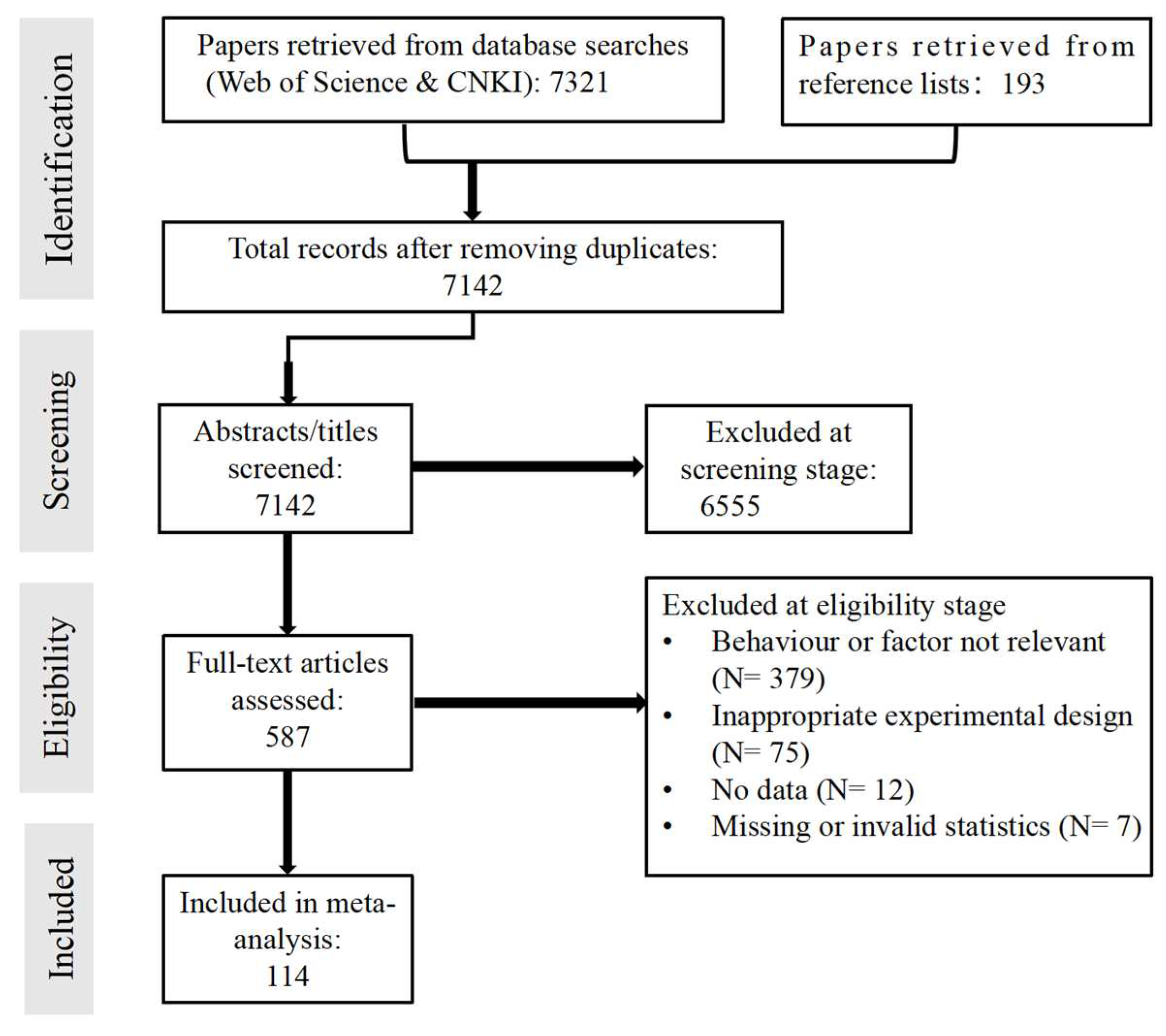
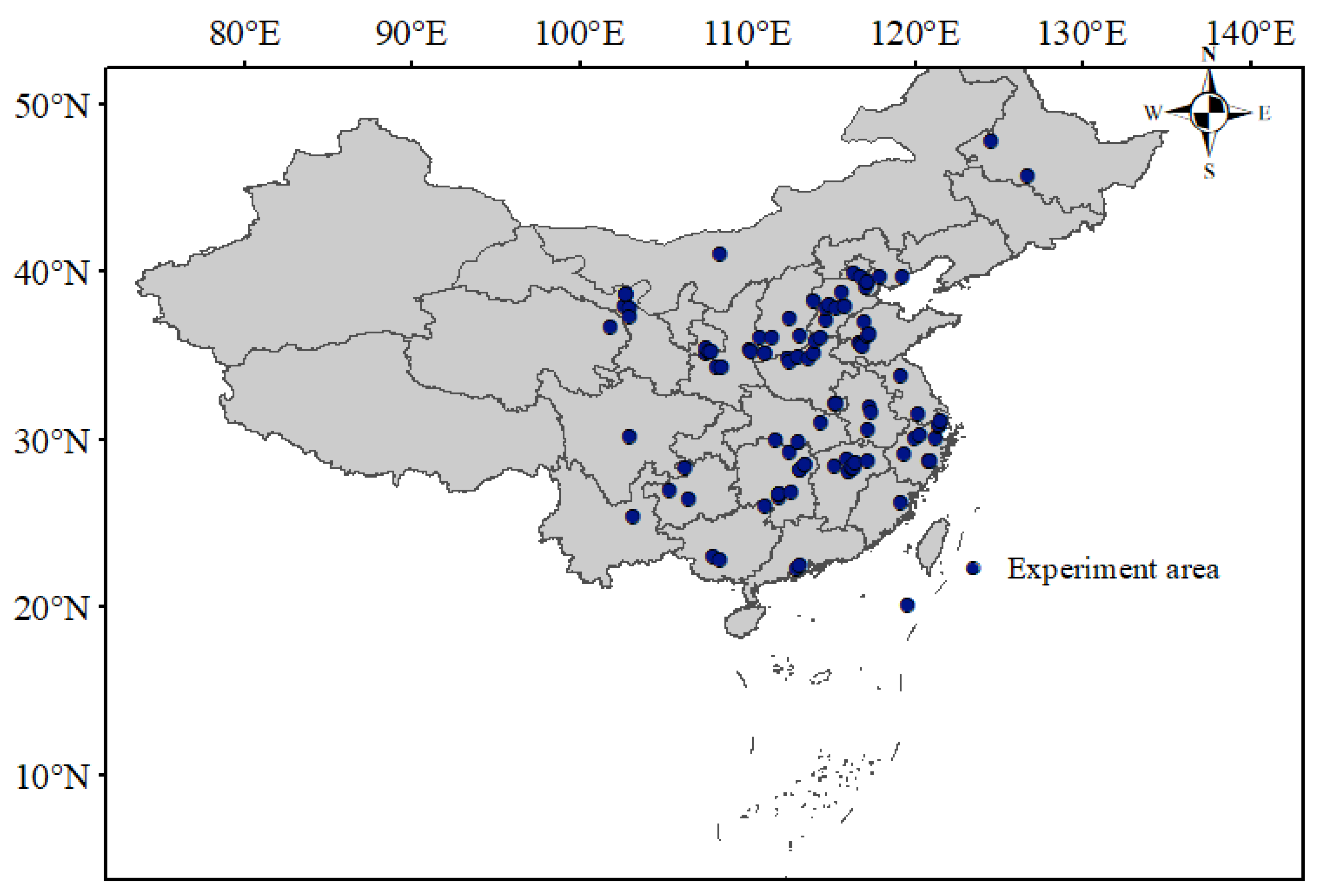
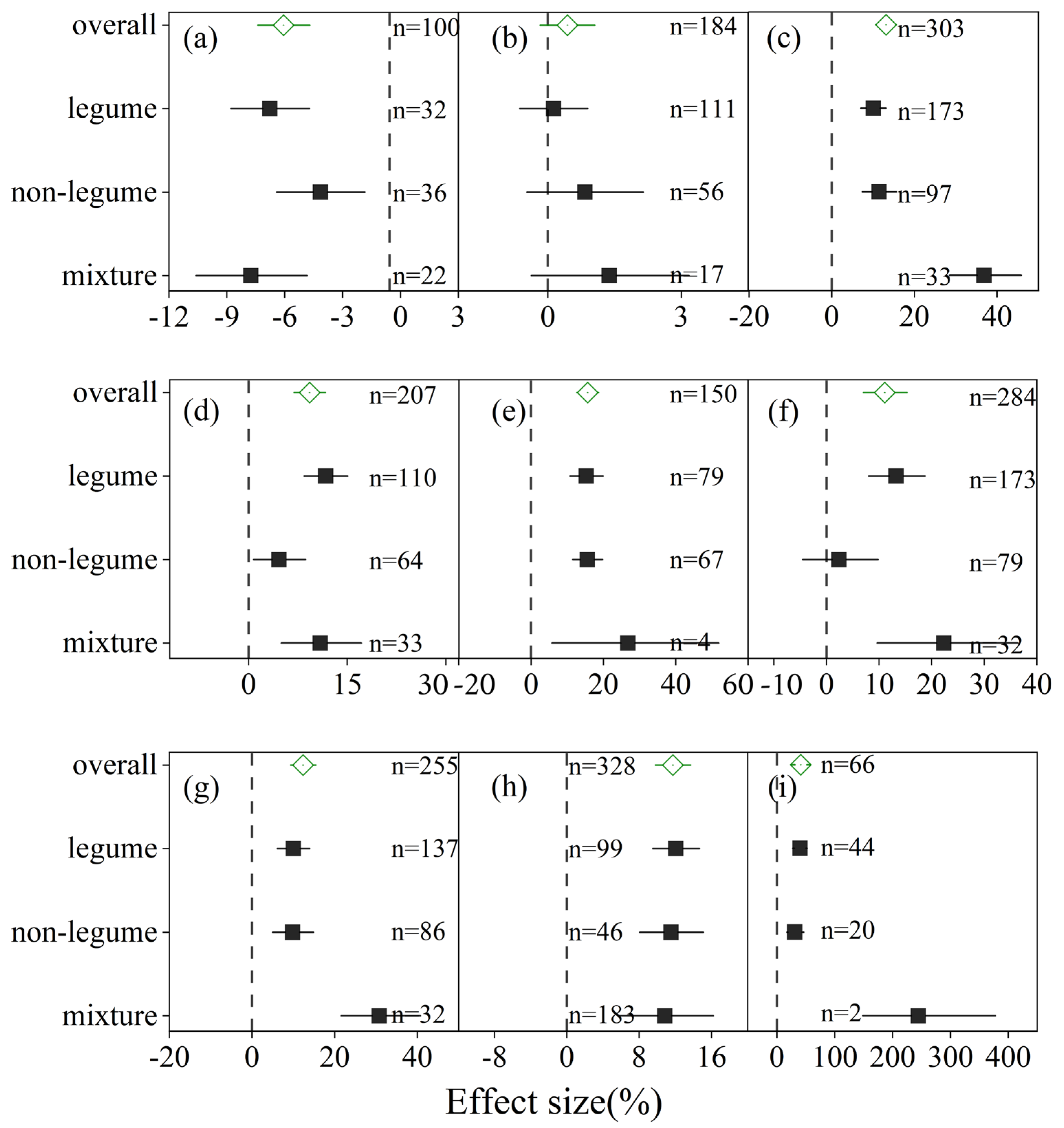
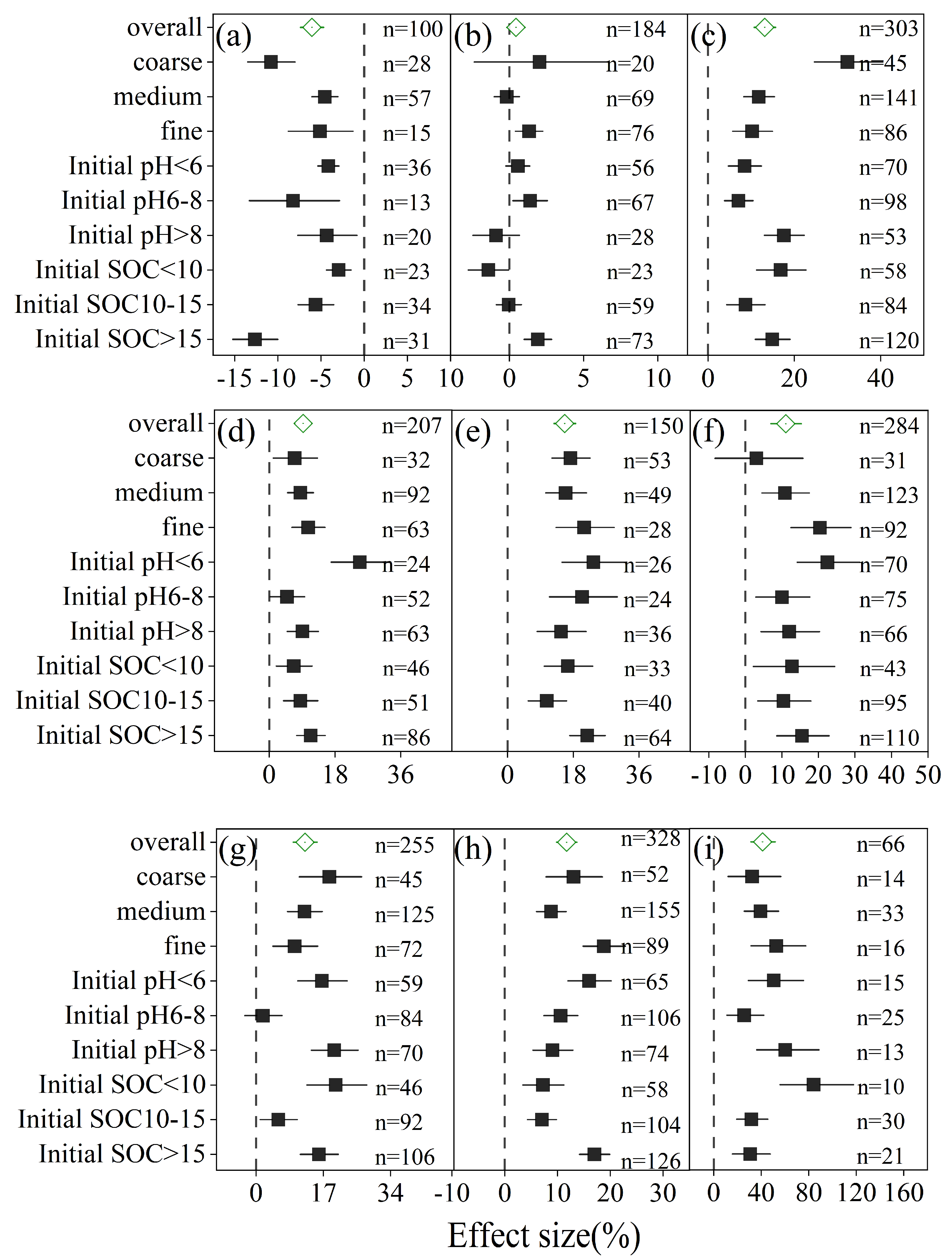
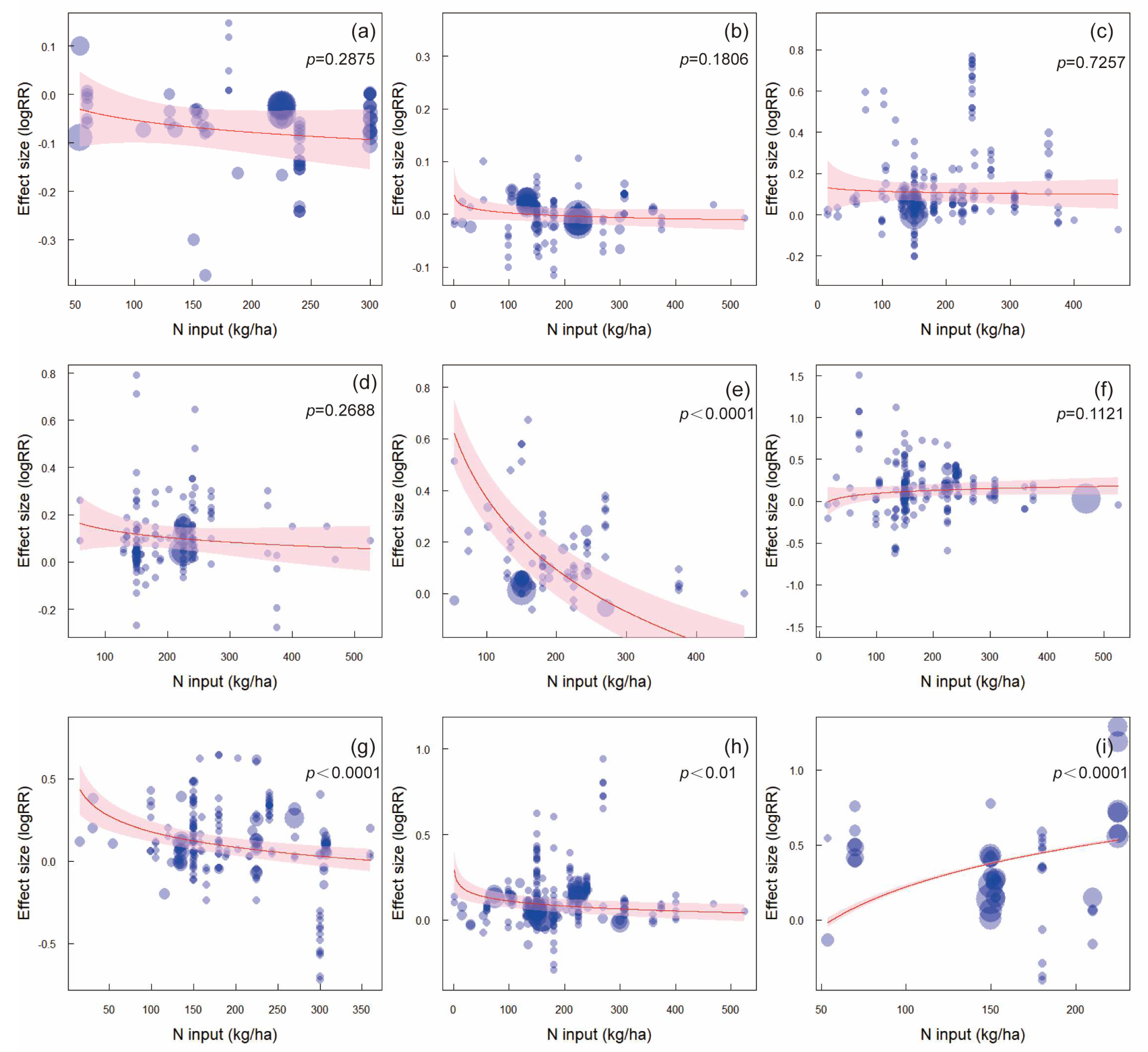

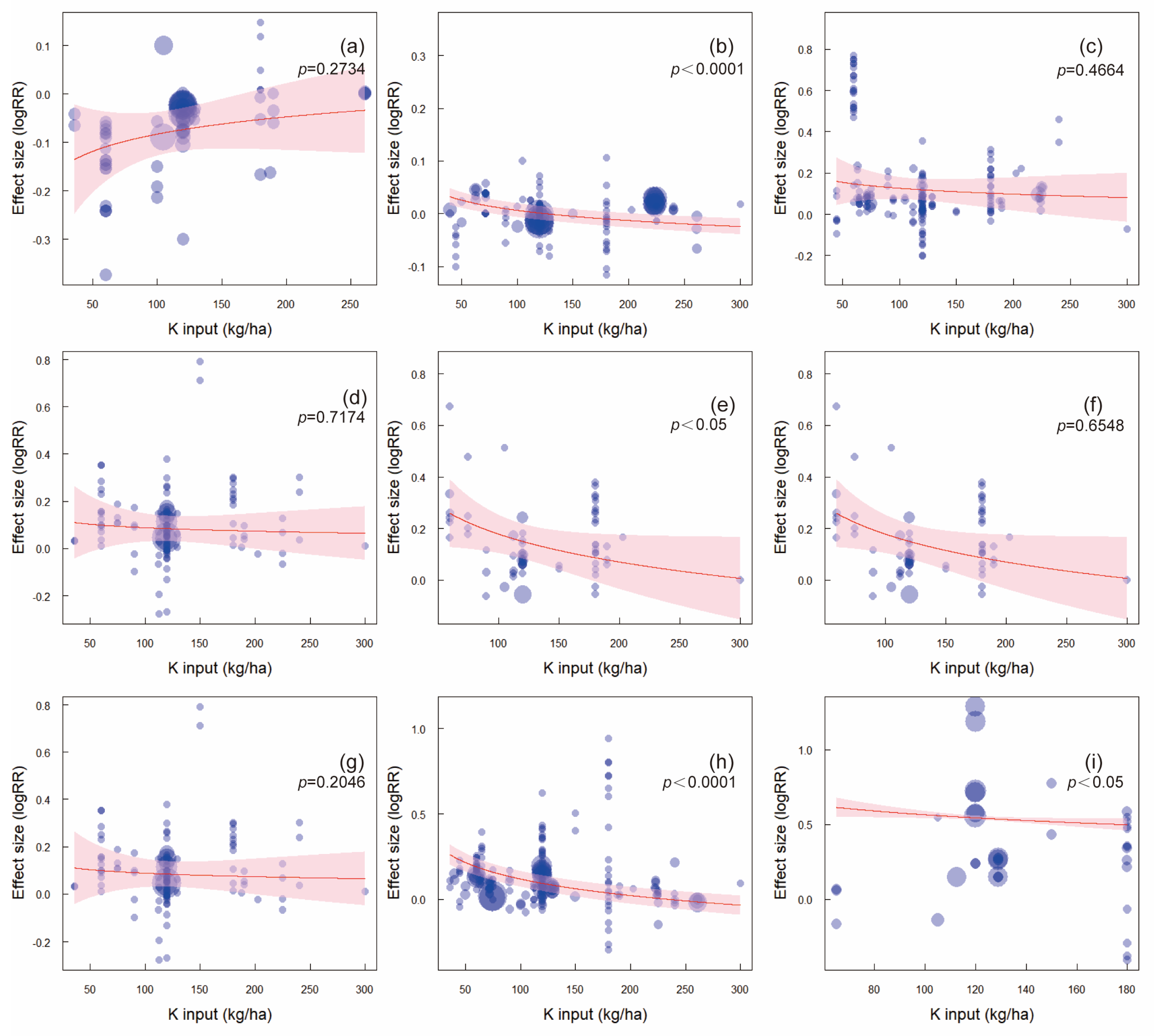
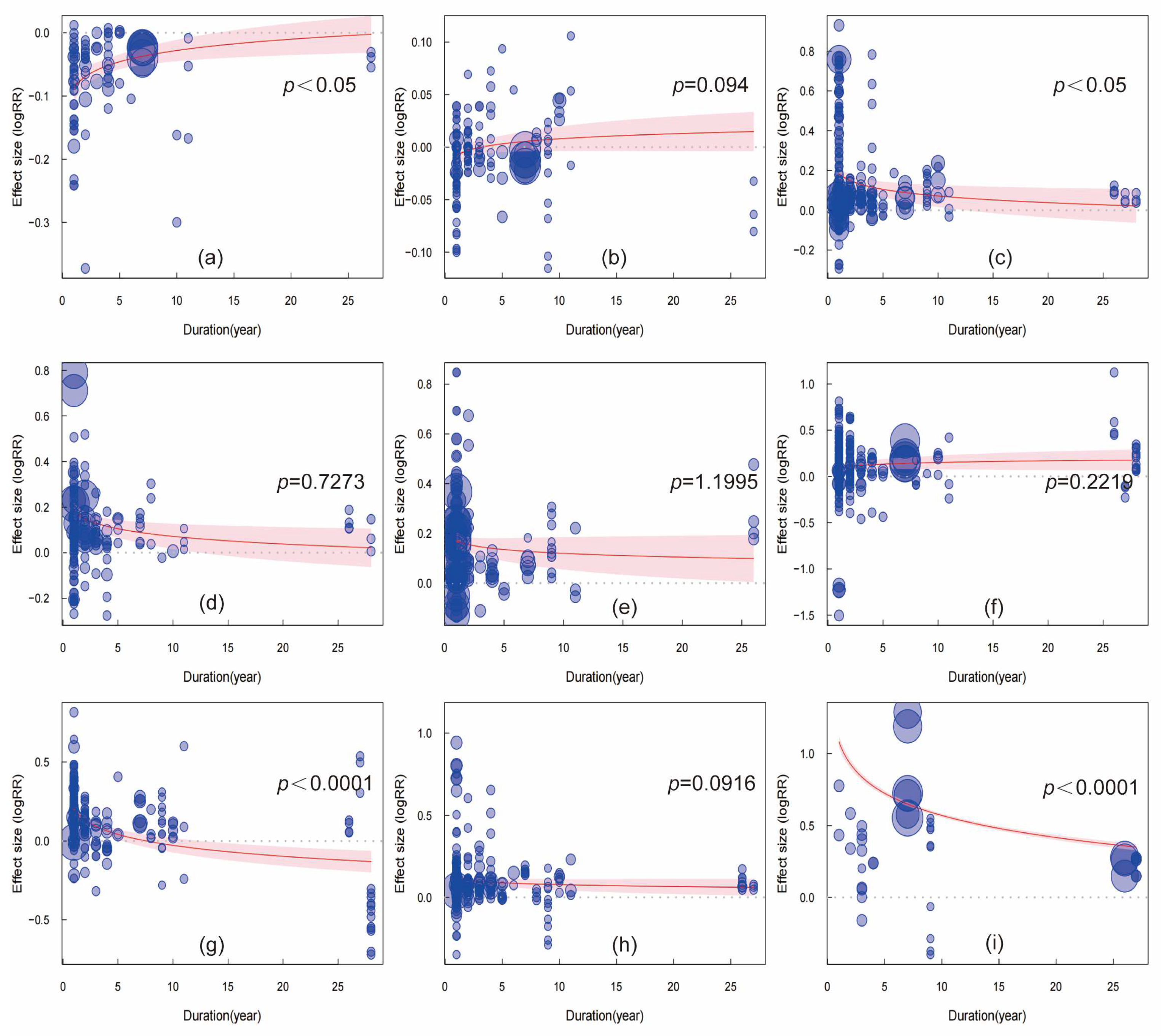
Disclaimer/Publisher’s Note: The statements, opinions and data contained in all publications are solely those of the individual author(s) and contributor(s) and not of MDPI and/or the editor(s). MDPI and/or the editor(s) disclaim responsibility for any injury to people or property resulting from any ideas, methods, instructions or products referred to in the content. |
© 2025 by the authors. Licensee MDPI, Basel, Switzerland. This article is an open access article distributed under the terms and conditions of the Creative Commons Attribution (CC BY) license (https://creativecommons.org/licenses/by/4.0/).
Share and Cite
Ma, J.; Yin, B.; Gao, T.; He, K.; Huang, X.; Jiang, T.; Zhen, W. Legume–Non-Legume Cover Crop Mixtures Enhance Soil Nutrient Availability and Physical Properties: A Meta-Analysis Across Chinese Agroecosystems. Agronomy 2025, 15, 1756. https://doi.org/10.3390/agronomy15081756
Ma J, Yin B, Gao T, He K, Huang X, Jiang T, Zhen W. Legume–Non-Legume Cover Crop Mixtures Enhance Soil Nutrient Availability and Physical Properties: A Meta-Analysis Across Chinese Agroecosystems. Agronomy. 2025; 15(8):1756. https://doi.org/10.3390/agronomy15081756
Chicago/Turabian StyleMa, Jiayu, Baozhong Yin, Tian Gao, Kaixiao He, Xinqin Huang, Tiantong Jiang, and Wenchao Zhen. 2025. "Legume–Non-Legume Cover Crop Mixtures Enhance Soil Nutrient Availability and Physical Properties: A Meta-Analysis Across Chinese Agroecosystems" Agronomy 15, no. 8: 1756. https://doi.org/10.3390/agronomy15081756
APA StyleMa, J., Yin, B., Gao, T., He, K., Huang, X., Jiang, T., & Zhen, W. (2025). Legume–Non-Legume Cover Crop Mixtures Enhance Soil Nutrient Availability and Physical Properties: A Meta-Analysis Across Chinese Agroecosystems. Agronomy, 15(8), 1756. https://doi.org/10.3390/agronomy15081756





